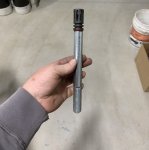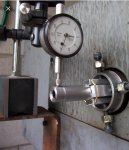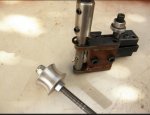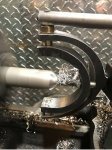IM trying to slowly but surly get everything together to build my first rifle. Thread, chamber, true the receiver, ect . Everything im looking at over at PT&G is "manufactured to order" I dont feel like rolling the dice from some of the other post ive read. Who else is there ? Manson and?
Join the Hide community
Get access to live stream, lessons, the post exchange, and chat with other snipers.
Register
Download Gravity Ballistics
Get help to accurately calculate and scope your sniper rifle using real shooting data.

Install the app
How to install the app on iOS
Follow along with the video below to see how to install our site as a web app on your home screen.
Note: This feature may not be available in some browsers.
You are using an out of date browser. It may not display this or other websites correctly.
You should upgrade or use an alternative browser.
You should upgrade or use an alternative browser.
Gunsmithing If not pacific tool and gauge then who?
- Thread starter airborne6.8
- Start date
I would avoid dealing with PTG directly at all costs. I only buy their stuff from Brownells and only if I can’t find it made by anybody else. I have had good performance equally with Manson and JGS for reamers. No real need to look elsewhere. They also both make pilot bushings that measure on the dot. I buy my range rods, mandrels, and receiver raceway bushings from Greg Tannel at Gretan rifles. All my fixture work is shop made.
Greg also has videos on truing receivers and sleeving bolts if you are interested. They are very helpful.
The PT&G reamers I’ve ordered have all been good with the exception of 1. I switched to Manson to avoid the long wait times and because I could read the writing on the wall. Manson and JGS reamers are gtg, Manson customer service is also very good!
I've used Manson for decades and added JGS for carbide and some tooling that Dave doesn't make.
Both are good.
Both are good.
Also, how many actions are you planning on “truing”? A kit might not be cost effective for you
Also, how many actions are you planning on “truing”? A kit might not be cost effective for you
there is absolutely no telling. Lol. by kit what do you mean? I’m just wanting to learn how to do it on a lathe. Why? I guess I’m just wired that way. I know it’s going to cost me a ton. But you can’t buy experience and time with my sons.
Kiff and Manson both sell a kit that includes raceway reamer, tap, bushings, etc. I have one, it’s a waste of money in my opinion. If I were to buy again I would get the raceway reamer and appropriate bushings and dial in off of that. If your lathe is rigid enough single pointing is the better way to do it. That’s just my opinion and it’s worth about what it costs
Kiff and Manson both sell a kit that includes raceway reamer, tap, bushings, etc. I have one, it’s a waste of money in my opinion. If I were to buy again I would get the raceway reamer and appropriate bushings and dial in off of that. If your lathe is rigid enough single pointing is the better way to do it. That’s just my opinion and it’s worth about what it costs
Appreciate the info.
I’ve purchased alot of tools from PT&G and always got what i ordered. The last 2 reamers from JGS didn’t cut as good but no need to bash. I inspect all the tools i buy on a comparator against the print. PTG I’ve been getting reamers in about 4-5 weeks.
I would recommend against you getting into single-pointing your receiver threads at this point in your endeavors.
Barrel work is not particularly difficult with basic lathe experience in turning, facing, and threading.
Picking up and re-cutting internal blind threads requires a lot of practice before you should risk trashing a $300. M700 receiver- and it doesn't take much in the way of operator error for that to happen.
IMO, unless you're building a benchrest competition rifle and are a highly skilled shooter- forget single-pointing the threads. There's minimal gain, a lot of risk for you. True the receiver face, lug abutments if you must- even there, lapping will usually get the job done. If you take too much off the lug abutments, you will need to re-time your bolt handle.
Spend the money on your blank, and a quality reamer, and take all the time needed for a perfect chambering setup and you won't look back.
For most, a receiver with minimal work will still shoot better than they can.
JMO, and as said above- worth exactly what you paid for it.
Barrel work is not particularly difficult with basic lathe experience in turning, facing, and threading.
Picking up and re-cutting internal blind threads requires a lot of practice before you should risk trashing a $300. M700 receiver- and it doesn't take much in the way of operator error for that to happen.
IMO, unless you're building a benchrest competition rifle and are a highly skilled shooter- forget single-pointing the threads. There's minimal gain, a lot of risk for you. True the receiver face, lug abutments if you must- even there, lapping will usually get the job done. If you take too much off the lug abutments, you will need to re-time your bolt handle.
Spend the money on your blank, and a quality reamer, and take all the time needed for a perfect chambering setup and you won't look back.
For most, a receiver with minimal work will still shoot better than they can.
JMO, and as said above- worth exactly what you paid for it.
Have always had good luck with PT&G. No they do not ship as fast as Amazon but PT&G is making their stuff and Amazon is just selling someone else stuff.
Appreciate this.I would recommend against you getting into single-pointing your receiver threads at this point in your endeavors.
Barrel work is not particularly difficult with basic lathe experience in turning, facing, and threading.
Picking up and re-cutting internal blind threads requires a lot of practice before you should risk trashing a $300. M700 receiver- and it doesn't take much in the way of operator error for that to happen.
IMO, unless you're building a benchrest competition rifle and are a highly skilled shooter- forget single-pointing the threads. There's minimal gain, a lot of risk for you. True the receiver face, lug abutments if you must- even there, lapping will usually get the job done. If you take too much off the lug abutments, you will need to re-time your bolt handle.
Spend the money on your blank, and a quality reamer, and take all the time needed for a perfect chambering setup and you won't look back.
For most, a receiver with minimal work will still shoot better than they can.
JMO, and as said above- worth exactly what you paid for it.
Excellent advice.I would recommend against you getting into single-pointing your receiver threads at this point in your endeavors.
Barrel work is not particularly difficult with basic lathe experience in turning, facing, and threading.
Picking up and re-cutting internal blind threads requires a lot of practice before you should risk trashing a $300. M700 receiver- and it doesn't take much in the way of operator error for that to happen.
IMO, unless you're building a benchrest competition rifle and are a highly skilled shooter- forget single-pointing the threads. There's minimal gain, a lot of risk for you. True the receiver face, lug abutments if you must- even there, lapping will usually get the job done. If you take too much off the lug abutments, you will need to re-time your bolt handle.
Spend the money on your blank, and a quality reamer, and take all the time needed for a perfect chambering setup and you won't look back.
For most, a receiver with minimal work will still shoot better than they can.
JMO, and as said above- worth exactly what you paid for it.
I've been using Manson exclusively for a few years now. Really good cutting and always on spec. He has done more than a few wildcats for me and we talk on the phone every so often.
As for accurizing, I'll sort of echo what people are saying. Square up the faces, lugs, etc.
Do you have access to a mill also ? Or only a lathe ? I can give you some "easier" jobs to learn on, some of this things I've given my apprentices over the years to skill them up.
As for accurizing, I'll sort of echo what people are saying. Square up the faces, lugs, etc.
Do you have access to a mill also ? Or only a lathe ? I can give you some "easier" jobs to learn on, some of this things I've given my apprentices over the years to skill them up.
I've been using Manson exclusively for a few years now. Really good cutting and always on spec. He has done more than a few wildcats for me and we talk on the phone every so often.
As for accurizing, I'll sort of echo what people are saying. Square up the faces, lugs, etc.
Do you have access to a mill also ? Or only a lathe ? I can give you some "easier" jobs to learn on, some of this things I've given my apprentices over the years to skill them up.
I don’t but that’s on my radar for sure. Be handy around the farm as well. I’ll take any projects to help teach me. Just figuring out what tool does what cut is a head scratcher at time. Lol. Been a long time since I was in a machine shop. But I am starting to get threading down. I think.
Attachments
This is a true statement.I would recommend against you getting into single-pointing your receiver threads at this point in your endeavors.
Barrel work is not particularly difficult with basic lathe experience in turning, facing, and threading.
Picking up and re-cutting internal blind threads requires a lot of practice before you should risk trashing a $300. M700 receiver- and it doesn't take much in the way of operator error for that to happen.
IMO, unless you're building a benchrest competition rifle and are a highly skilled shooter- forget single-pointing the threads. There's minimal gain, a lot of risk for you. True the receiver face, lug abutments if you must- even there, lapping will usually get the job done. If you take too much off the lug abutments, you will need to re-time your bolt handle.
Spend the money on your blank, and a quality reamer, and take all the time needed for a perfect chambering setup and you won't look back.
For most, a receiver with minimal work will still shoot better than they can.
JMO, and as said above- worth exactly what you paid for it.
I'm not sure when the whole "you MUST recut the threads" started, but, they used to build plenty of benchrest rifles by truing the action face and lapping the lugs.
A square action face, along with a square recoil lug and square shoulder on the barrel are importanta, but the most important thing is a concentric, well cut chamber.
I've seen some incredibly accurate rifles that were built by facing the action and lapping the lugs.
Now, some of the larger operations like LRI absolutely recut the threads, and Chad's reasoning is very sound and impossible to argue with.
If you are brave enough, put a collet chuck in your lathe, mount an end mill in it, and clamp an alloy block in your tool post. Start your lathe up. You can do simple milling operations now.
Also look at making a spider for the back of your lathe. The project covers identifying your current thread (if your lathe had one, which 90% do), cutting a thread to suit without having the ability keep checking your fit, like you would with a brake. This is the old "measure twice, cut once" thing.
Lastly, make a nice quality radius cutter. There's a bunch of different ways to make it, get some heavy wall pipe, like the picture (not mine) shows.
Lastly is a negative radius cutter.
With a little creativity, you could make some wavy looking rod, part it off, then machine some flats on it like a hex bar, and turn it into crazy looking bolt knobs or muzzle brakes.
This should be more than enough projects to see out the year. If you need or want any advice or tech pointers, help, technique to machine something, just ask (drop me a PM).
Also look at making a spider for the back of your lathe. The project covers identifying your current thread (if your lathe had one, which 90% do), cutting a thread to suit without having the ability keep checking your fit, like you would with a brake. This is the old "measure twice, cut once" thing.
Lastly, make a nice quality radius cutter. There's a bunch of different ways to make it, get some heavy wall pipe, like the picture (not mine) shows.
Lastly is a negative radius cutter.
With a little creativity, you could make some wavy looking rod, part it off, then machine some flats on it like a hex bar, and turn it into crazy looking bolt knobs or muzzle brakes.
This should be more than enough projects to see out the year. If you need or want any advice or tech pointers, help, technique to machine something, just ask (drop me a PM).
Attachments
If you are brave enough, put a collet chuck in your lathe, mount an end mill in it, and clamp an alloy block in your tool post. Start your lathe up. You can do simple milling operations now.
Also look at making a spider for the back of your lathe. The project covers identifying your current thread (if your lathe had one, which 90% do), cutting a thread to suit without having the ability keep checking your fit, like you would with a brake. This is the old "measure twice, cut once" thing.
Lastly, make a nice quality radius cutter. There's a bunch of different ways to make it, get some heavy wall pipe, like the picture (not mine) shows.
Lastly is a negative radius cutter.
With a little creativity, you could make some wavy looking rod, part it off, then machine some flats on it like a hex bar, and turn it into crazy looking bolt knobs or muzzle brakes.
This should be more than enough projects to see out the year. If you need or want any advice or tech pointers, help, technique to machine something, just ask (drop me a PM).
I for sure will. Thanks a million.
Similar threads
- Replies
- 29
- Views
- 1K
- Replies
- 22
- Views
- 2K
Precision Rifle Gear
Tango Innovations FIRE4000 WMLRF Initial Impressions
- Replies
- 346
- Views
- 29K




